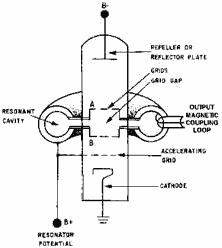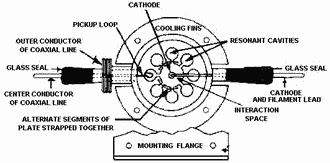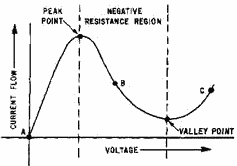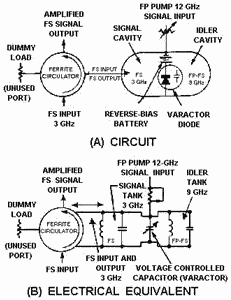Module 11 − Microwave Principles Pages
i,
1−1, 1−11,
1−21,
1−31,
1−41,
1−51,
1−61,
2−1,
2−11, 2−21,
2−31,
2−41,
2−51,
2−61,
3−1,
3−11,
AI−1,
Index−1,
Assignment 1,
Assignment 2

The TWT is a wide-bandwidth, velocity-modulated tube used primarily as an amplifier. The electron beam
is bunched by a signal applied to the Helix. The bunching causes an energy transfer from the electron beam to the
traveling wave on the helix. The MAGNETRON is a DIODE Oscillator capable of delivering microwave energy at
very high power levels. Three fields exist within a magnetron that influence operation: (1) the DC ELECTRIC FIELD
between the anode and cathode; (2) the AC ELECTRIC FIELD produced by the oscillating resonant cavities and on the
same plane as the dc field; and (3) the Magnetic FIELD produced by the permanent magnet which is perpendicular to
the dc electric field. Magnetrons are of two basic types, the Negative-Resistance MAGNETRON and the
ELECTRON-RESONANCE MAGNETRON. a diagram of a magnetron is shown at the right.

2-61
SOLID-STATE Microwave DEVICES are becoming increasingly widespread in
microwave equipment with new developments almost daily. Most of the currently available solid-state devices are
two-terminal diodes with the capability to generate or amplify microwave energy. Many of the solid-state devices,
such as the TUNNEL DIODE and the BULK-EFFECT DIODE, apply the property of Negative Resistance to amplify microwave
signals or generate microwave energy. a characteristic curve illustrating the negative-resistance property of the
tunnel diode is shown at the right.

The VARACTOR is a two-terminal diode that acts as a variable capacitance and is the active element of
PARAMETRIC AmplifierS. The parametric amplifier is a low-noise microwave amplifier that uses variable reactance to
amplify microwave signals. The illustration shows an example of a NONDegenerative PARAMETRIC Amplifier. 2-62

Answers to Questions Q1. Through Q74.
A-1. Impedance decreases. A-2. Degenerative feedback. A-3. Transit time causes the grid
voltage and plate current to be out of phase. A-4. Transit time. A-5. Velocity. A-6. The
electron will be accelerated. A-7. By alternately speeding up or slowing down the electrons. A-8.
The buncher grids. A-9. There is no effect. A-10. The frequency period of the buncher grid signal.
A-11. Velocity modulation.
2-63
A-12. The accelerator grid and the buncher grids. A-13. The catcher cavity. A-14. Amplifier.
A-15. Intermediate cavities between the input and output cavities. A-16. a large negative pulse is
applied to the cathode. A-17. The middle cavity. A-18. The bandwidth decreases. A-19.
Stagger tuning. A-20. The reflector or repeller. A-21. Velocity. A-22. Three-quarter
cycle. A-23. Mode 2. A-24. Power is reduced. A-25. The half-power points of the mode. A-26.
Voltage amplification. A-27. used to focus the electrons into a tight beam. A-28. The directional
couplers are not physically connected to the helix. A-29. The traveling wave must have a forward velocity
equal to or less than the speed of the electrons in the beam. A-30. The helix. A-31. Helix. A-32. a magnetic field. A-33. Anode or plate. A-34. The resonant cavities. A-35. The
permanent magnet.
A-36. The critical value of field strength. A-37. Circular. A-38. The negative-resistance
magnetron has a split plate. A-39. The application of the proper magnetic field.
2-64
A-40. To reduce the effects of filament bombardment. A-41. Rising-sun block. A-42.
Series.
A-43. Working electrons. A-44. Greater power output. A-45. Loops and slots. A-46.
Inductive. A-47. a cookie-cutter tuner. A-48. Baking in. A-49. The tunneling action. A-50. The tuned circuit or cavity frequency. A-51. To increase the stability. A-52. Prevent
feedback to the tuned input circuit. A-53. Stability problems. A-54. Variable capacitor. A-55. Reactance.
A-56. The low-noise characteristic. A-57. By varying the amount of capacitance in the circuit. A-58. Supplies the electrical energy required to vary the capacitance. A-59. Exactly double the input
frequency. A-60. The pump signal of a nondegenerative parametric amplifier is higher than twice the input
signal. A-61. Idler- or lower-sideband frequency. A-62. The sum of the input frequency and the
pump frequency. A-63. Larger microwave power outputs. A-64. The electrons become immobile. A-65. Threshold. A-66. a field of much greater intensity. A-67. The frequency. 2-65
A-68. PNIN. A-69. The negative-resistance property. A-70. To form a small region of
p-type material. A-71. Lower. A-72. Lower forward resistance and low noise. A-73. Variable
resistance.
A-74. a switching device. 2-66
| - |
Matter, Energy,
and Direct Current |
| - |
Alternating Current and Transformers |
| - |
Circuit Protection, Control, and Measurement |
| - |
Electrical Conductors, Wiring Techniques,
and Schematic Reading |
| - |
Generators and Motors |
| - |
Electronic Emission, Tubes, and Power Supplies |
| - |
Solid-State Devices and Power Supplies |
| - |
Amplifiers |
| - |
Wave-Generation and Wave-Shaping Circuits |
| - |
Wave Propagation, Transmission Lines, and
Antennas |
| - |
Microwave Principles |
| - |
Modulation Principles |
| - |
Introduction to Number Systems and Logic Circuits |
| - |
- Introduction to Microelectronics |
| - |
Principles of Synchros, Servos, and Gyros |
| - |
Introduction to Test Equipment |
| - |
Radio-Frequency Communications Principles |
| - |
Radar Principles |
| - |
The Technician's Handbook, Master Glossary |
| - |
Test Methods and Practices |
| - |
Introduction to Digital Computers |
| - |
Magnetic Recording |
| - |
Introduction to Fiber Optics |
| Note: Navy Electricity and Electronics Training
Series (NEETS) content is U.S. Navy property in the public domain. |
|













